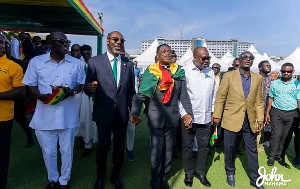Opinions of Monday, 9 August 2010
Columnist: Casely-Hayford, Sydney
NDC, Lying With The Truth
By Sydney Casely-Hayford, [email protected]
A year ago on 10th July 2009, I wrote an article attacking NDC public truths. NDC Big and Small Lies Will Un-Make the Party. Actually walking the soil and riding Mass Metro Transit, Tro-Tro and taxis in Ghana, trying to make sense out of the complex economic chains, is an eye opener of how the macro and micro economic environments are separate from each other. Ghana is two economies. The macro numbers, which capture the attention of academia, the donor community and the regulatory authorities and the micro economy, where 80% of Ghanaians live and struggle to make a living. In stark contrast to each other, visualize the banking hall of Stanchart, Ecobank, Barclays or any of the others and juxtapose that against the trade paths in Makola and Mallam markets or the lines of kiosks on the road sides of Odorkor and Palladium and other peri-urban communities.
We are seeing an ever-widening gap between the poor and those who are managing to stay “un-poor” and the two worlds overlap when they pay their water and electricity bills or make purchases on one of Ghana’s busiest shopping malls; the traffic jammed streets.
When the NDC took over in January, they consolidated their victory on the deficit “mess” left for them by the NPP government. They negotiated a 3-year SDR387.45million facility with the IMF in addition to other facilities and proceeded to sort out the economy.
After 17 months into their term, most basic services have not improved but the Government has claimed macro economic stability as its hallmark of achievement and single digit inflation as indication of progress. On the streets and markets, reduced inflation has not made its way to the food prices yet.
But what the NDC Government has failed to make clear to all of us is that the inflation target comes with conditions tied to the borrowing from the IMF (See Appendix I of the Combined First and Second Reviews under the ECF arrangement, Technical Memorandum of Understanding paragraph 6). Inasmuch it is a good target to aim for, we are under strict instructions not to move outside specified inner and outer bands. For inflation, these bands for September are upper limit, outer band – 12.5%, upper limit, inner band – 11.5%, lower limit, outer band – 7.5%, lower limit, inner band – 6.5%. The central target rate of inflation is 9.5% to the end of 2010. Last June, inflation was reported as 9.52%. Mere co-incidence? Doubtful because of paragraph 18 (quoted below) of the above mentioned document and the NDC track record on numbers.
“The authorities (Government of Ghana) will complete consultation with the Executive Board of the Fund on the proposed policy response before requesting further purchases under the program when the observed year-on-year CPI inflation rate moves outside the outer band as specified for the end of each quarter in the above table. The authorities will not be able to request any further disbursements under the ECF arrangement if inflation moves outside of the outer band until the consultation with the Executive Board has taken place”. (emphasis mine).
To continue to draw on the ECF with the IMF, we are bound within these limits. The recently completed review allows a further immediate draw, even though we did not achieve all the benchmarks and we missed the one most visible target, that of passing the Freedom of Information Bill (FOI). Same as I concluded on the Mabey and Johnson corruption issue (Guide to Corruption Series) this NDC Government WILL NOT pass the FOI Bill during this term. There is too much discomfort hidden in the archives of the PNDC.
On tariffs, paragraph 2 of the Statement by the IMF Staff Representative on Ghana is very clear. It is the reason why the Government of Ghana (GoG) is confident it can meet demands from the TUC and affiliates and still court the IMF facility. On this one issue, GoG played clever, using the PURC as the fall guy and can now come across as the good cop looking after the poor and championing their cause.
Below is a straight lift from the IMF report.
“Adjustments to electricity and water tariffs. On May 31, 2010, Ghana’s Public Utility Regulatory Commission (PURC) announced increases in electricity and water tariffs, effective June 1, 2010, marking the first increase in both tariff schedules since November 2007. Electricity tariffs have been increased by between 21 and 42 percent for residential users and by 63 to 130 percent for non-residential users. The subsidized lifeline tariff for small residential users was left unchanged. The average electricity tariff, weighted by 2009 sales, increased by 58 percent, substantially exceeding the increase of 33 percent established as a prior action for the completion of the second ECF review. The PURC noted that, based on projected generating costs, these tariffs would broadly cover operating costs, while continuing budget support would be needed to finance new investments and plant refurbishment. Water tariffs have been increased by 21 to 32 percent for residential users, and by 40 to 64 percent for non-residential users. The PURC also announced that it is considering reintroducing an automatic formula for the periodic adjustment of tariffs.”
Clearly, there was no expectation to pass the full cost recovery to the consumer. The IMF had recommended a 2-stage recovery and felt this would be more manageable for Ghanaians. Manufacturing asked for this and so also all Unions and bulk users.
It would be so much easier to share the conditions attached to borrowing with Ghanaians. We all know we are living on donor largesse and our future hinges on the new oil and gas find. At least, until we get there, why not just say we have to take this bitter pill for a while. After all the last quarter of 2010 is just round the corner.










